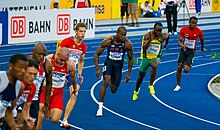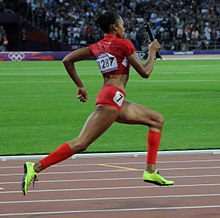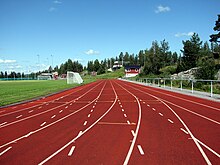

Sprinting is running over a short distance at the top-most speed of the body in a limited period of time. It is used in many sports that incorporate running, typically as a way of quickly reaching a target or goal, or avoiding or catching an opponent. Human physiology dictates that a runner's near-top speed cannot be maintained for more than 30–35 seconds due to the depletion of phosphocreatine stores in muscles, and perhaps secondarily to excessive metabolic acidosis as a result of anaerobic glycolysis.[1]
In athletics and track and field, sprints (or dashes) are races over short distances. They are among the oldest running competitions, being recorded at the Ancient Olympic Games. Three sprints are currently held at the modern Summer Olympics and outdoor World Championships: the 100 metres, 200 metres, and 400 metres.
At the professional level, sprinters begin the race by assuming a crouching position in the starting blocks before driving forward and gradually moving into an upright position as the race progresses and momentum is gained. The set position differs depending on the start. The use of starting blocks allows the sprinter to perform an enhanced isometric preload; this generates muscular pre-tension which is channeled into the subsequent forward drive, making it more powerful. Body alignment is of key importance in producing the optimal amount of force. Ideally, the athlete should begin in a 4-point stance and drive forwards, pushing off using both legs for maximum force production.[2] Athletes remain in the same lane on the running track throughout all sprinting events,[1] with the sole exception of the 400 metres indoors. Races up to 100 metres are largely focused upon acceleration to an athlete's maximum speed.[2] All sprints beyond this distance increasingly incorporate an element of endurance.[3]
|
See also: History of physical training and fitness |

The first 13 editions of the Ancient Olympic Games featured only one event—the stadion race, which was a sprinting race from one end of the stadium to the other.[4] The Diaulos (Δίαυλος, "double pipe") was a double-stadion race, c. 400 metres (1,300 feet), introduced in the 14th Olympiad of the ancient Olympic Games (724 BC).
Sprint races were part of the original Olympic Games in the 7th century B.C. as well as the first modern Olympic Games which started in the late 19th century (Athens 1896)[5] and featured the 100 meters and 400 meters. Athletes started both races from a crouched start (4-point stance). In both the original Olympics and the modern Olympics, only men were allowed to participate in track and field until the 1928 games in Amsterdam, Netherlands.[6] The 1928 games were also the first games to use a 400-meter track, which became the standard for track and field.
The modern sprinting events have their roots in races of imperial measurements which were later altered to metric: the 100 m evolved from the 100-yard dash,[7] the 200 m distance came from the furlong (or 1⁄8 mile),[8] and the 400 m was the successor to the 440-yard dash or quarter-mile race.[1]
Technological advances have always improved sprint performances (i.e., starting blocks, synthetic track material, and shoe technology). In 1924, athletes used a small shovel to dig holes to start the race. The world record in the 100-meter dash in 1924 was 10.4 seconds, while in 1948, (the first use of starting blocks) was 10.2 seconds, and was 10.1 seconds in 1956. The constant drive for faster athletes with better technology has brought man from 10.4 seconds to 9.58 seconds in less than 100 years.
Track events were measured with the metric system except for the United Kingdom and the United States until 1965 and 1974 respectively. The Amateur Athletic Association (AAU)[citation needed] decided to switch track and field in the U.S. to the metric system to finally make track and field internationally equivalent.
Biological factors that determine a sprinter's potential include:

Note: Indoor distances are less standardized, as many facilities run shorter or occasionally longer distances depending on available space. 60 m is the championship distance.


The event was a common event for most American students because it was one of the standardized test events as part of the President's Award on Physical Fitness.[12]
The 50 metres is an uncommon event and alternative to the 60 metres. Donovan Bailey holds the men's world record with a time of 5.56 seconds and Irina Privalova holds the women's world record with a time of 5.96 seconds.
|
Main article: 60-yard dash |
The 55 metres is an uncommon event that resulted from the metrication of the 60 yards and is an alternative to the 60 metres.
An extremely rare sprinting event, that was occasionally run in the 1960s. The world record of 6.90 is held by Bob Hayes.


The stadion, also known as the stade, was the standard short distance sprint in ancient Greece and ran the length of a stadium. However, stadiums could vary in size and there was apparently no definite standard length for them, e.g., the stadium at Delphi measures 177 m and the one at Pergamon 210 m.[16]
The diaulos was an event contested in the Ancient Greek Olympia that was double the length of a stadion.

As well as standard foot races, in Ancient Greece there was also a sprint race called the hoplitodromos ('armed diaulos'[20]). This required the sprinters to additionally carry a large shield and wear a helmet. Similarly to the diaulos, they ran two stades in length i.e. one stade ending with a 180 degree turn around a post, which led onto the second stade in length back down the track.[21] In the diaulos, each sprinter had an individual post to run around.[22] However, for some hoplitodromos races all of the sprinters ran around a single central post.[23]
Typically, a sprinter only needs two types of shoes, training shoes and sprinting spikes.[24]
Sprinting spikes are typically designed to be lightweight, with a minimal cushion on the heels and a plate on the forefoot to keep the runner on the toes of each foot. The spike plate will typically have the maximum number of holes for metal spikes to be inserted to keep a proper grip on the track surface. These metal removable spikes also come in varying sizes. The spikes typically range from 4 mm to 15 mm and come in different styles. Most facilities have specific requirements for what size and style spikes can be used.[25]
Starting blocks are not a necessity but are highly suggested for use in sprinting events. Starting blocks are a piece of equipment that typically consists of foot pads attached to a central rail. The point of using blocks is to help the athlete push themselves further down the track as quickly as possible.
The baton is a required element for any relay race. The baton is passed to each athlete through different exchange zones, with different techniques. Typically, about 1 foot (0.30 m) and 1.5 inches (3.8 cm) in diameter.
Used typically in training sessions to measure relative times and recovery times. Stopwatches are not always the most accurate way to measure times in a race setting,
Fully Automatic Timing (FAT) and gate systems are used to accurately measure races, with results as accurate as up to 1/1000 of a second.[28]
As of 2021, World Athletics (WA) [29] is the governing body for track and field around the world. Every country that wishes to participate in WA competitions must become a member.[30]
Each governing body sets its own rules for how competition is deemed fair. World Athletics sets the competition rules internationally. The World Athletics rulebook[31] is broken into 4 separate books.

Starting blocks are used for all competition sprints (up to and including 400 m) and relay events (first leg only, up to 4x400 m).[32] The starting blocks consist of two adjustable footplates attached to a rigid frame. Races commence with the firing of the starter's gun.[32] The starting commands are "On your marks" and "Set".[32] Once all athletes are in the set position, the starter's gun is fired, officially starting the race. For the 100 m, all competitors are lined up side by side. For the 200 m, 300 m, and 400 m, which involve curves, runners are staggered for the start.
In the rare event that there are technical issues with a start, a green card is shown to all the athletes. The green card carries no penalty. If an athlete is unhappy with track conditions after the "on your marks" command is given, the athlete must raise a hand before the "set" command and provide the Start referee with a reason. It is then up to the Start referee to decide if the reason is valid. If the Start referee deems the reason invalid, a yellow card (warning) is issued to that particular athlete. If the athlete is already on a warning, the athlete is disqualified.
|
Main article: False start § Athletics (track and field) |

According to the World Athletics (WA) rules, "An athlete, after assuming a full and final set position, shall not commence his starting motion until after receiving the report of the gun or approved starting apparatus. If, in the judgement of the Starter or Recallers, he does so any earlier, it shall be deemed a false start."[32]
The 100 m Olympic gold and silver medallist Linford Christie of Great Britain famously had frequent false starts that were marginally below the legal reaction time of 0.1 seconds. Christie and his coach, Ron Roddan, both claimed that the false starts were due to Christie's exceptional reaction times being under legal time. His frequent false starting eventually led to his disqualification from the 1996 Summer Olympics 100 m final in Atlanta, the US, due to a second false start by Christie. Since January 2010, under WA rules, a single false start by an athlete resulted in disqualification.
In 2012, a new development to the false start rule was added. Because certain athletes could be disqualified for twitching in the starting blocks, but some athletes could make a twitch without the starter noticing and disqualifying the athlete, it was decided that twitching in the starting block while being in the 'set' position would only carry a maximum penalty of a yellow card or a warning. To instantly be disqualified for a false start, an athlete's hands must leave the track or their feet must leave the starting blocks, while the athlete is in their final 'set' position.[33]

For all Olympic sprint events, runners must remain within their pre-assigned lanes, which measure 1.22 metres (4 feet) wide, from start to finish.[34] The lanes can be numbered 1 through 8, 9, or rarely 10, starting with the inside lane. Any athlete who runs outside the assigned lane to gain an advantage is subject to disqualification. If the athlete is forced to run outside of his or her lane by another person, and no material advantage is gained, there will be no disqualification. Also, a runner who strays from his or her lane in the straightaway, or crosses the outer line of his or her lane on the bend, and gains no advantage by it, will not be disqualified as long as no other runner is obstructed.
The first athlete whose torso reaches the vertical plane of the closest edge of the finish line is the winner. To ensure that the sprinter's torso triggers the timing impulse at the finish line rather than an arm, foot, or other body parts, a double Photocell is commonly used. Times are only recorded by an electronic timing system when both of these Photocells are simultaneously blocked. Photo finish systems are also used at some track and field events.
| Discipline | Performance | Competitor | Country | Venue | Date |
|---|---|---|---|---|---|
| 50 meters | 5.96 | Irina Privalova[36] | RUS[37] | Madrid (ESP) | 09 FEB 1995 |
| 60 meters | 6.92 | Irina Privalova[36] | RUS[37] | Madrid (ESP) | 09 FEB 1995 |
| 100 meters | 10.49 | Florence Griffith-Joyner[38] | USA[39] | Indianapolis, IN (USA) | 16 JUL 1988 |
| 200 meters (indoors) | 21.87 | Merlene Ottey[40] | JAM[41] | Lievin (FRA) | 13 FEB 1993 |
| 200 meters (outdoors) | 21.34 | Florence Griffith-Joyner[38] | USA[39] | Olympic Stadium, Jamsil, Seoul (KOR) | 29 SEP 1988 |
| 400 meters (indoors) | 49.26 | Femke Bol[42] | NLD | Omnisport, Apeldoorn (NLD) | 19 FEB 2023 |
| 400 meters (outdoors) | 47.60 | Marita Koch[43] | GDR | Bruce Stadium, Canberra (AUS) | 06 OCT 1985 |
| 4x100 meter relay | 40.82 | Tianna Bartoletta,[44] Allyson Felix,[45] Bianca Knight,[46] Carmelita Jeter[47] | USA[39] | Olympic Stadium, London (GBR) | 10 AUG 2012 |
| 4x200 meter relay (indoors) | 1:32.41 | Yuliya Gushchina,[48] Yuliya Pechonkina,[49] Irina Khabarova,[50] Yekaterina Kondratyeva[51] | RUS[37] | Glasgow (GBR) | 29 JAN 2005 |
| 4x200 meter relay (outdoors) | 1:27.46 | Marion Jones,[52] Nanceen Perry,[53] LaTasha Colander,[54] LaTasha Jenkins[55] | USA[39] | Philadelphia, PA (USA) | 29 APR 2000 |
| 4x400 meter relay (indoors) | 3:23.37 | Yuliya Gushchina,[48] Olga Kotlyarova,[56] Olga Zaytseva,[57] Olesya Krasnomovets-Forsheva[58] | RUS[37] | Glasgow (GBR) | 28 JAN 2006 |
| 4x400 meter relay (outdoors) | 3:15.17 | Tatyana Ledovskaya,[59] Olga Nazarova,[60] Mariya Pinigina,[61] Olga Bryzgina[62] | URS | Olympic Stadium, Jamsil, Seoul (KOR) | 01 OCT 1988 |
| Discipline | Performance | Competitor | Country | Venue | Date |
|---|---|---|---|---|---|
| 50 meters | 5.56 | Donovan Bailey[63] | CAN[64] | Reno, NV (USA) | 09 FEB 1996 |
| 60 meters | 6.34 | Christian Coleman[65] | USA[39] | Albuquerque, NM (USA) | 18 FEB 2018 |
| 100 meters | 9.58 | Usain Bolt[66] | JAM[41] | Olympiastadion, Berlin (GER) | 16 AUG 2009 |
| 200 meters (indoors) | 19.92 | Frank Fredericks[67] | NAM[68] | Liévin (FRA) | 18 FEB 1996 |
| 200 meters (outdoors) | 19.19 | Usain Bolt[66] | JAM[41] | Olympiastadion, Berlin (GER) | 20 AUG 2009 |
| 400 meters (indoors) | 44.57 | Kerron Clement[69] | USA[39] | Fayetteville, AR (USA) | 12 MAR 2005 |
| 400 meters (outdoors) | 43.03 | Wayde Van Niekerk[70] | RSA[71] | Estádio Olímpico, Rio de Janeiro (BRA) | 14 AUG 2016 |
| 4x100 meter relay | 36.84 | Nesta Carter,[72] Michael Frater,[73] Yohan Blake,[74] Usain Bolt[66] | JAM[41] | Olympic Stadium, London (GBR) | 11 AUG 2012 |
| 4x200 meter relay (indoors) | 1:22.11 | John Regis,[75] Ade Mafe,[76] Darren Braithwaite,[77] Linford Christie[78] | GBR[79] | Glasgow (GBR) | 03 MAR 1991 |
| 4x200 meter relay (outdoors) | 1:18.63 | Nickel Ashmeade,[80] Warren Weir,[81] Jermaine Brown,[82] Yohan Blake[74] | JAM[41] | T. Robinson Stadium, Nassau (BAH) | 24 MAY 2014 |
| 4x400 meter relay (indoors) | 3:01.51 | Amere Lattin,[83] Obi Igbokwe,[84] Jermaine Holt,[85] Kahmari Montgomery[86] | USA[39] | Clemson, SC (USA) | 09 FEB 2019 |
| 4x400 meter relay (outdoors) | 2:54.29 | Michael Johnson,[87] Harry "Butch" Reynolds,[88] Quincy Watts,[89] Andrew Valmon[90] | USA[39] | Gottlieb-Daimler Stadion, Stuttgart (GER) | 22 AUG 1993 |
| Discipline | Performance | Competitor | Country | Venue | Date |
|---|---|---|---|---|---|
| 4x400 meter relay mixed | 3:08.80 | Justin Robinson, Rosey Effiong, Matthew Bowling, Alexis Holmes | USA[39] | National Athletics Centre, Budapest (HUN) | 19 AUG 2023 |
While genetics play a large role in one's ability to sprint,[91][92][93] athletes must be dedicated to their training to ensure that they can optimize their performances. Sprint training includes various running workouts, targeting acceleration, speed development, speed endurance, special endurance, and tempo endurance. Additionally, athletes perform intense strength training workouts, as well as plyometric or jumping workouts. Collectively, these training methods produce qualities that allow athletes to be stronger, and more powerful, in hopes of ultimately running faster.[94]